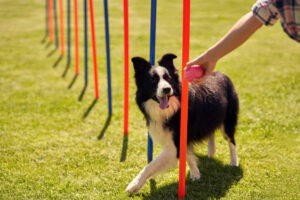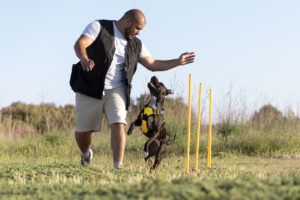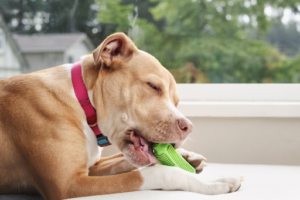Dog body language consists of a variety of distinct strategies for transmitting emotions and intentions. It may differ significantly from how people communicate.
Understanding dog body language is an essential part of being a dog parent. From tail wagging and dog barking to dog licking and biting, there are all sorts of dog behaviors that reveal how a dog is feeling.
In this article, we’ll explore dog body language and the meaning behind some of their most common behaviors.
Dog Body Language Explained: What Do They Mean?
According to the Cummings School of Veterinary Medicine, in order to fully understand dog body language, you must look at their entire body. That includes looking at the dog’s eyes, ears, tail position, and overall posture.
This section talks about dog behaviors and what they mean!
Rolling over
A dog turning over onto his back might imply a variety of things. Unless you’ve taught your dog how to roll over on command, this behavior is typically used to say, “I’m not a danger.”
If the tail is softly wagging and the mouth is slightly open, the dog is most likely content and requesting a belly massage.
That said, rolling over in the presence of other dogs isn’t necessarily just a cute act. Researchers evaluated the behaviors that accompanied rolling when canines played with other dogs in a new study. They concluded that rolling is a battle technique, not automatically a sign of surrender. It could be a dog’s way of both intimidating and appeasing its opponent at the same time.
Tail Wagging
A wagging tail indicates that the dog is emotionally stimulated. It may be joy, but it could also be frustration or worse. Look at the pace and direction of the wag, as well as the location of the tail, to assess the dog’s emotions and intents.
A loose wag, not too high or too low, usually signifies that the dog is comfortable and friendly, but be sure to pay attention to the animal’s body language in its entirety. Some dogs may need a lot of room. They’ll definitely let you know if you’re too close.
Downward Dog
When dogs lean towards the yoga pose named for them (buttocks in the air, chest and front legs splayed out in front), it usually signifies they’re ready for some fun. Ready your frisbee!
Tail Tucking
If your pup is frightened and her tail is tucked between her legs, she’s displaying appeasement behavior. This is a sign that she would rather not confront whatever it is that has spooked her.
Shaking
Shaking is a beneficial way for dogs to release tension and ask for some distance. However, frequent head shaking could be a clue that your pup has an ear infection.
If you’re worried about your pup’s health or if you think it’s exhibiting strange behavior, contact your vet. Trembling, not just mere shaking, is especially telling and should be checked out by a vet.
Licking
Dogs lick each other to show affection, as well as themselves. Another dog may be trying out his new pal by licking him or her, while self-licking may indicate stress or anxiety.
It’s not unusual for dog owners to be licked too, though this could also mean that the dog is asking for a treat. It could also simply be trying to get your attention.
Biting
A dog licking you is one thing; if he bites you, however, it’s no laughing matter. Bite inhibition, or the dog’s ability to understand how hard he can bite without causing injury, is a key factor in dog safety – and it’s best not to let your dog practice that on humans.
Biting is a dog’s way of defending himself, so it’s important for dog owners to learn the proper steps of dog bite prevention and safety.
Conclusion
You will create a stronger sense of trust and respect if you learn what your dog is saying. Also, your increased awareness of your dog’s emotional condition will allow you to forecast his behavior and avert issues before they arise.
Learning to communicate with dogs is a continuous effort. Putting forth the effort to study their natural body language may help us better care for and advocate for all dogs, not just our own.
For more articles like these, don’t forget to check out PetFitness!







